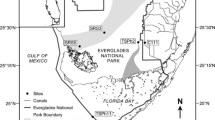Abstract
The activity of the heterotrophic microbial population in the saline Lake Grevelingen (The Netherlands) and the Mediterranean Etang Salses Leucate (France) was determined by measuring the oxygen consumption rate, and the uptake of 14C-labelled glycollate, pyruvate and an amino acid mixture. The maximum uptake rate of the applied organic compounds in Lake Grevelingen was generally less than 10% of the carbon mineralization rate calculated from the oxygen consumption experiments. Only for pyruvate and glycollate higher values were found of about 30 to 40% with one exceptionally high value for pyruvate of 149%. However, these higher percentages were found in winter, when the activity of the heterotrophic microbial population was very low. In Etang Salses Leucate higher maximum uptake rates of the 14C-labelled compounds were found, relating this uptake to the oxygen consumption rate. Yet the maximum uptake rate is still always lower than 35% of the carbon mineralization calculated from the oxygen uptake rate. Taking into account that maximum uptake rates were considered, the results demonstrate that the uptake of 14C-labelled organic compounds represents a serious underestimation of the activity of the bacterial population in situ. The extent of the underestimation depends on the water type. It was concluded that the determination of the heterotrophic activity by measuring oxygen consumption rates offers a better insight into the carbon mineralization process in natural waters than the uptake experiments with 14C-labelled substrates.
Similar content being viewed by others
Literature Cited
Bryan, J. R., J. P. Riley and P. J. LeB. Williams: A Winkler procedure for making precise measurements of oxygen concentration for productivity and related studies. J. exp. mar. Biol. Ecol. 21, 191–197 (1976)
Burnison, B. K. and R. Y. Morita: Heterotrophic potential for amino acid uptake in a naturally eutrophic lake. Appl. environ. Microbiol. 27, 488–495 (1974)
Dawson, R. and K. Gocke: Heterotrophic activity in comparison to the free amino acid concentrations in Baltic sea water samples. Oceanol. Acta 1, 45–54 (1978)
Dowd, J. E. and D. S. Riggs: A comparison of estimates of Michaelis-Menten kinetic constants from various linear transformations. J. Biol. Chem. 240, 863–869 (1965)
Gocke, K., R. Dawson and G. Liebezeit: Availability of dissolved free glucose to heterotrophic microorganisms. Mar. Biol. 62, 209–216 (1981)
Hagmeier, E.: Plankton-Äquivalente, Auswertungen von chemischen und mikroskopischen Analysen. Kiel. Meeresforsch. 17, 32–47 (1961)
Hobbie, J. E. and C. C. Crawford: Bacterial uptake of organic substrate: new methods of study and application to eutrophication. Verh. Internat. Verein. Limnol. 17, 725–730 (1969)
Parsons, T. R. and J. D. H. Strickland: On the production of particulate organic carbon by heterotrophic processes in sea water. Deep Sea Res. 8, 211–222 (1962)
Sepers, A. B. J.: The aerobic mineralization of amino acids in the saline Lake Grevelingen and the freshwater Haringvliet basin (The Netherlands). Arch. Hydrobiol. 92, 114–129 (1981)
Sepers, A. B. J. and F. B. van Es: Heterotrophic uptake experiments with 14C-labelled histidine in a histidine limited chemostat. Appl. environ. Microbiol. 37, 794–799 (1979)
Sorokin, Y. I. and H. Kadota: Techniques for the assessment of microbial production and decomposition in fresh waters, 112 pp. IBP Handbook No. 23. Oxford: Blackwell Scientific Publications 1972
Straškrabova, V.: Oxygen methods for measuring the activity of water bacteria. Arch. Hydrobiol. Beih. Ergebn. Limnol. 12, 3–10 (1979)
Strickland, J. D. H. and T. R. Parsons: A practical handbook of seawater analysis, 311 pp. Ottawa: Fish. Res. Bd Can. Bull. 167 (1968)
Williams P. J. LeB.: Microbial contribution to overall marine plankton metabolism: direct measurements of respiration. Oceanol. Acta 4, 359–364 (1981)
Author information
Authors and Affiliations
Additional information
Communicated by O. Kinne, Hamburg
Communication no. 228 of the Delta Institute for Hydrobiological Research, Yerseke, The Netherlands
Rights and permissions
About this article
Cite this article
Sepers, A.B.J., Cahet, G. & Goossens, H. Comparison between the carbon-14 and oxygen consumption method for the determination of the activity of heterotrophic bacterial populations. Mar. Biol. 66, 237–242 (1982). https://doi.org/10.1007/BF00397028
Accepted:
Issue Date:
DOI: https://doi.org/10.1007/BF00397028




